For uniformly accelerated motion, we can derive some simple equations that relate displacement (x), time taken (t), initial velocity (v0), final velocity (v) and acceleration (a). Equation (3.6) already obtained gives a relation between final and initial velocities v and v0 of an object moving with uniform acceleration a :
v = v0 + at (3.6)
This relation is graphically represented in Fig. 3.12.
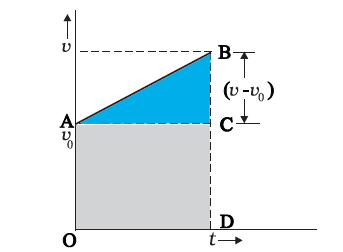
Fig. 3.12 Area under v-t curve for an object with uniform acceleration.
The area under this curve is :
Area between instants 0 and t = Area of triangle ABC + Area of rectangle OACD

As explained in the previous section, the area under v-t curve represents the displacement. Therefore, the displacement x of the object is :

But 
Therefore, 
or, 
Equation (3.7) can also be written as

where,

Equations (3.9a) and (3.9b) mean that the object has undergone displacement x with an average velocity equal to the arithmetic average of the initial and final velocities.
From Eq. (3.6), t = (v – v0)/a. Substituting this in Eq. (3.9a), we get


This equation can also be obtained by substituting the value of t from Eq. (3.6) into Eq. (3.8). Thus, we have obtained three important equations :



connecting five quantities v0, v, a, t and x. These are kinematic equations of rectilinear motion for constant acceleration.
The set of Eq. (3.11a) were obtained by assuming that at t = 0, the position of the particle, x is 0. We can obtain a more general equation if we take the position coordinate at t = 0 as non-zero, say x0. Then Eqs. (3.11a) are modified (replacing x by x – x0 ) to :



Example 3.3 Obtain equations of motion for constant acceleration using method of calculus.
Answer By definition

dv = a dt
Integrating both sides

 (a is constant)
(a is constant)


Further, 
dx = v dt
Integrating both sides




We can write

or, v dv = a dx
Integrating both sides,



The advantage of this method is that it can be used for motion with non-uniform acceleration also.
Now, we shall use these equations to some important cases.
Example 3.4 A ball is thrown vertically upwards with a velocity of 20 m s–1 from the top of a multistorey building. The height of the point from where the ball is thrown is 25.0 m from the ground. (a) How high will the ball rise ? and (b) how long will it be before the ball hits the ground? Take g = 10 m s–2.
Answer (a) Let us take the y-axis in the vertically upward direction with zero at the ground, as shown in Fig. 3.13.
Now vo = + 20 m s–1,
a = – g = –10 m s–2,
v = 0 m s–1
If the ball rises to height y from the point of launch, then using the equation

we get
0 = (20)2 + 2(–10)(y – y0)
Solving, we get, (y – y0) = 20 m.
(b) We can solve this part of the problem in two ways. Note carefully the methods used.
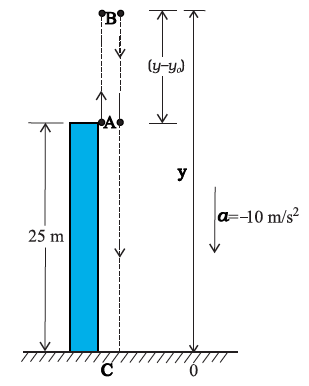
Fig. 3.13
FIRST METHOD : In the first method, we split the path in two parts : the upward motion (A to B) and the downward motion (B to C) and calculate the corresponding time taken t1 and t2. Since the velocity at B is zero, we have :
v = vo + at
0 = 20 – 10t1
Or, t1 = 2 s
This is the time in going from A to B. From B, or the point of the maximum height, the ball falls freely under the acceleration due to gravity. The ball is moving in negative y direction. We use equation

We have, y0 = 45 m, y = 0, v0 = 0, a = – g = –10 m s–2
0 = 45 + (½) (–10) t22
Solving, we get t2 = 3 s
Therefore, the total time taken by the ball before it hits the ground = t1 + t2 = 2 s + 3 s = 5 s.
SECOND METHOD : The total time taken can also be calculated by noting the coordinates of initial and final positions of the ball with respect to the origin chosen and using equation

Now y0 = 25 m y = 0 m
vo = 20 m s-1, a = –10m s–2, t = ?
0 = 25 +20 t + (½) (-10) t2
Or, 5t2 – 20t – 25 = 0
Solving this quadratic equation for t, we get
t = 5s
Note that the second method is better since we do not have to worry about the path of the motion as the motion is under constant acceleration.
Example 3.5 Free-fall : Discuss the motion of an object under free fall. Neglect air resistance.
Answer An object released near the surface of the Earth is accelerated downward under the influence of the force of gravity. The magnitude of acceleration due to gravity is represented by g. If air resistance is neglected, the object is said to be in free fall. If the height through which the object falls is small compared to the earth’s radius, g can be taken to be constant, equal to 9.8 m s–2. Free fall is thus a case of motion with uniform acceleration.
We assume that the motion is in y-direction, more correctly in –y-direction because we choose upward direction as positive. Since the acceleration due to gravity is always downward, it is in the negative direction and we have
a = – g = – 9.8 m s–2
The object is released from rest at y = 0. Therefore, v0 = 0 and the equations of motion become:
v = 0 – g t = –9.8 t m s–1
y = 0 – ½ g t2 = –4.9 t2 m
v2 = 0 – 2 g y = –19.6 y m2 s–2
These equations give the velocity and the distance travelled as a function of time and also the variation of velocity with distance. The variation of acceleration, velocity, and distance, with time have been plotted in Fig. 3.14(a), (b) and (c).
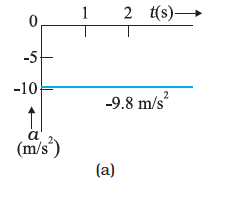
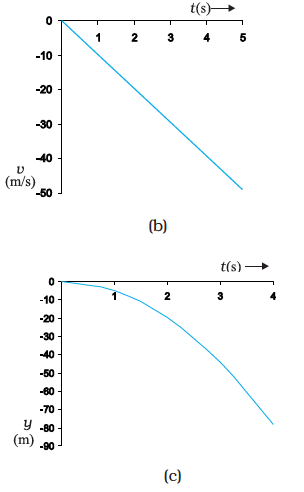
Fig. 3.14 Motion of an object under free fall. (a) Variation of acceleration with time.
(b) Variation of velocity with time.
(c) Variation of distance with time t
Example 3.6 Galileo’s law of odd numbers : “The distances traversed, during equal intervals of time, by a body falling from rest, stand to one another in the same ratio as the odd numbers beginning with unity [namely, 1: 3: 5: 7…...].” Prove it.
Answer Let us divide the time interval of motion of an object under free fall into many equal intervals  and find out the distances traversed during successive intervals of time. Since initial velocity is zero, we have
and find out the distances traversed during successive intervals of time. Since initial velocity is zero, we have

Using this equation, we can calculate the position of the object after different time intervals, 0, τ, 2τ, 3τ… which are given in second column of Table 3.2. If we take (–1/ 2) gτ2 as y0 — the position coordinate after first time interval τ, then third column gives the positions in the unit of yo. The fourth column gives the distances traversed in successive τs. We find that the distances are in the simple ratio 1: 3: 5: 7: 9: 11… as shown in the last column. This law was established by Galileo Galilei (1564-1642) who was the first to make quantitative studies of free fall.

Example 3.7 Stopping distance of vehicles : When brakes are applied to a moving vehicle, the distance it travels before stopping is called stopping distance. It is an important factor for road safety and depends on the initial velocity (v0) and the braking capacity, or deceleration, –a that is caused by the braking. Derive an expression for stopping distance of a vehicle in terms of vo and a.
Answer Let the distance travelled by the vehicle before it stops be ds. Then, using equation of motion v2 = vo2 + 2 ax, and noting that v = 0, we have the stopping distance

Thus, the stopping distance is proportional to the square of the initial velocity. Doubling the initial velocity increases the stopping distance by a factor of 4 (for the same deceleration).
For the car of a particular make, the braking distance was found to be 10 m, 20 m, 34 m and 50 m corresponding to velocities of 11, 15, 20 and 25 m/s which are nearly consistent with the above formula.
Stopping distance is an important factor considered in setting speed limits, for example, in school zones. t
Example 3.8 Reaction time : When a situation demands our immediate action, it takes some time before we really respond. Reaction time is the time a person takes to observe, think and act. For example, if a person is driving and suddenly a boy appears on the road, then the time elapsed before he slams the brakes of the car is the reaction time. Reaction time depends on complexity of the situation and on an individual.
You can measure your reaction time by a simple experiment. Take a ruler and ask your friend to drop it vertically through the gap between your thumb and forefinger (Fig. 3.15). After you catch it, find the distance d travelled by the ruler. In a particular case, d was found to be 21.0 cm. Estimate reaction time.
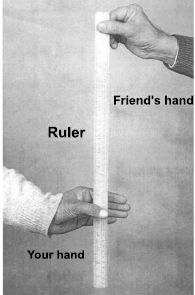
Fig. 3.15 Measuring the reaction time.
Answer The ruler drops under free fall. Therefore, vo = 0, and a = –g = –9.8 m s–2. The distance travelled d and the reaction time tr are related by

Or, 
Given d = 21.0 cm and g = 9.8 m s–2 the reaction time is
